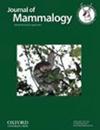蝙蝠家园范围大小相关因素的回顾和荟萃分析
IF 1.6
3区 生物学
Q2 ZOOLOGY
引用次数: 0
摘要
家园范围是一个生态学概念,影响着脊椎动物生活的许多方面,因此了解不同物种之间家园范围的变化至关重要。哺乳动物的家园范围大小与体型和饮食有关,但这些研究主要基于陆生物种,尤其不包括蝙蝠。作为哺乳动物中唯一的飞行类群,蝙蝠在运动时会受到截然不同的限制,因此它们的家园范围也不尽相同。然而,尽管蝙蝠的种类繁多,但人们对其家园范围的了解却相对较少,这是首次对蝙蝠家园范围大小的相关因素进行评估的全球性综述。我们的假设是,蝙蝠所经历的不同生态条件以及蝙蝠本身的生物特征都会对家园范围产生影响。我们根据已发表的 81 种蝙蝠的数据进行了荟萃分析,以确定对家园范围大小影响最大的变量。性别、翅膀负荷、功能群、群落大小、食物类别、与赤道的距离(纬度区域)、栖息地类型以及栖息地类型与纬度区域之间的交互作用都是重要的解释变量。翅膀负荷与家园范围大小呈正相关--而雌性、露天觅食者、大群落规模和温带地区的蝙蝠始终拥有较大的家园范围。了解蝙蝠家园范围的相关因素对保护蝙蝠、评估人畜共患病病原体从蝙蝠向人类和家畜传播的风险等方面具有重要意义。本文章由计算机程序翻译,如有差异,请以英文原文为准。
Review and meta-analysis of correlates of home range size in bats
Home range is an ecological concept that affects many aspects of the life of vertebrates and hence understanding how it varies between species is crucial. Mammalian home range size has been linked to body size and diet, but these studies were based predominantly on terrestrial species and most specifically excluded bats. As the only group of flying mammals, bats experience distinctly different constraints on movement, and hence home range. However, despite their diversity, relatively little is known about the home ranges of bats, and this is the first global review assessing correlates of their home range size. Our hypothesis is that home range will be impacted by different ecological conditions experienced by the bats and by the biological traits of the bats themselves. We performed a meta-analysis based on published data for 81 bat species to identify variables that contribute most to home range size. Sex, wing loading, functional group, colony size, dietary class, distance from the equator (latitudinal region), habitat type, and the interaction between habitat type and latitudinal region were all important explanatory variables. Wing loading was positively correlated with home range size—while females, open-air foragers, large colony sizes, and bats in temperate regions consistently had large home ranges. Understanding the correlates of home range has important implications, for example, for bat conservation and for assessing the risk of spillover of zoonotic pathogens from bats to humans and livestock.
求助全文
通过发布文献求助,成功后即可免费获取论文全文。
去求助
来源期刊

Journal of Mammalogy
生物-动物学
CiteScore
3.30
自引率
5.90%
发文量
106
审稿时长
4-8 weeks
期刊介绍:
Papers are published on mammalian behavior, conservation, ecology, genetics, morphology, physiology, and taxonomy.
 求助内容:
求助内容: 应助结果提醒方式:
应助结果提醒方式:


